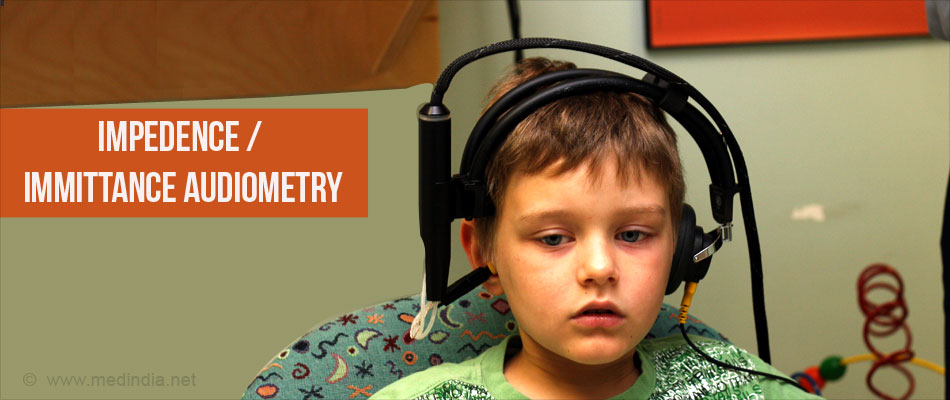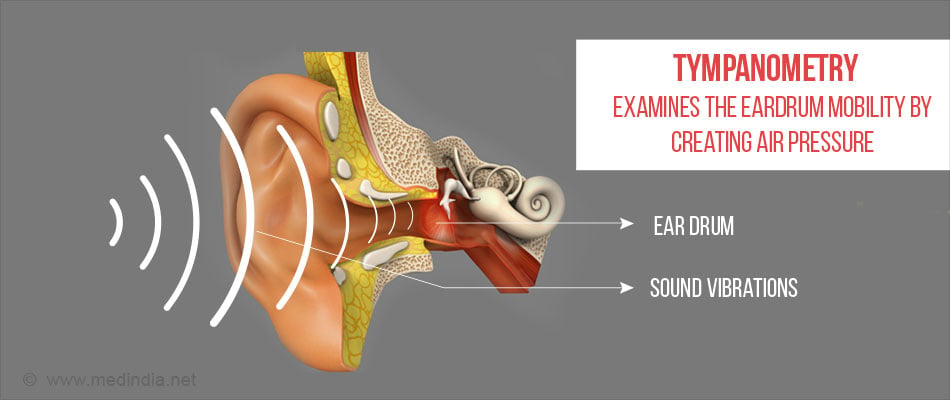- Information about Tympanometry - (http://www.aafp.org/afp/2004/1101/p1713.html)
- About Tympanometry - (https://en.wikipedia.org/wiki/tympanometry)
- Tympanometry - (http://www.thebsa.org.uk/wp-content/uploads/2014/04/bsa_rp_tymp_final_21aug13_final.pdf)
- More on Tympanometry - (http://www.asha.org/policy/rp1988-00027/)
What is Audiometry - Impedance/Immittance?
Audiometry is a non-invasive and painless procedure to measure hearing sensitivity of an individual. The hearing test is performed using sounds of single frequency, tested at various intensity levels and determining the lowest loudness level that the person is able to hear in each frequency. The tone of a single frequency, called pure tone, is presented into the ear canal through an earphone. The testing is done across frequencies of human hearing range. The sounds presented at the external ear, travels through the ear canal, middle ear, inner ear and then through the auditory nerve to be processed in the brain. Such a test enables the identification of hearing problems at various levels in the auditory system. Audiometry test can be performed to decide if a person is suitable and can benefit from cochlear implant surgery.
Impedance audiometry is a group of tests that determine the status of the eardrum or the tympanic membrane and the middle ear. Immittance audiometry is a way to understand the manner of energy flow through the outer, middle and inner ear and beyond. The measurements include tympanometry, acoustic reflex testing and acoustic immittance measurement.

Tympanometry is an objective test and the results of the test help in the understanding of the following parameters:
- The status of the eardrum and the middle ear.
- Functioning of the reflex pathways of hearing, involving the facial nerve, vestibulocochlear nerve and the auditory brainstem.
- The three tiny bones of the middle ear.
- Eustachian tube function.
- The two muscles of the middle ear – tensor tympani and the stapedius muscle.
- Functioning of the cochlea.
Earlier, these measurements were performed with a procedure that uses impedance or resistance of the tympanic membrane and was called impedance audiometry. The modern procedure uses the combination of the flow and resistance of the sound energy and is now called immittance audiometry.
Acoustic immittance is the measurement of the energy or the air pressure flow involving the middle ear structures, cochlea and the auditory pathways.
Components of an Audiometry - Impedance/Immittance
The instrument used for the procedure of immittance audiometry is a specialized audiometer. The components of an immittance audiometer are:
- Probe tone oscillator and loudspeaker for sending sound signals into the ear
- Microphone for measuring the returning sound signals
- Pressure pump to vary the pressure in the ear canal
- Oscillator and loudspeaker on the other side of the headphone
- Soft rubber probe tip (detachable and changeable) to create airtight seal in the ear canal
What are the Indications of Audiometry - Impedance/Immittance?
Immittance tests are used to identify various pathologies of the hearing systems. Indications for a tympanometry include various symptoms related to the structure and function of the ear. The results of the test can indicate the following pathologies:
- Otosclerosis - Abnormal growth of bone near the middle ear
- Tympanosclerosis - Calcification of tissue in the eardrum
- Eustachian tube malfunction
- Hole or hypermobility of the tympanic membrane
- Fluid in the middle ear
- Discontinuity of the three tiny bones of the middle ear
- Acoustic neuroma - Benign intracranial tumor
- Disorder of the vestibulocochlear nerve (cranial nerve VIII)
- Selective disorders of the brainstem
- Hearing loss, along with results of pure tone audiometry
- Disorder of the facial nerve (cranial nerve VII)

Audiometry - Impedance/Immittance Procedure
During the procedure of immittance testing, the patient is asked to sit still and avoid swallowing as they may affect the results of the test.
The procedure for a tympanometry involves the following steps:
- The examiner first checks the ear canal with an otoscope.
- A probe with a soft plastic tip is inserted into the ear canal. It is fixed in the ear canal to obtain an airtight seal.
- A tone is presented in the ear canal. The air pressure of the canal is varied from +200 to -400 decapascal.
- The patient will feel the pressure variation in the ear canal at this time.
- The probe measures the eardrum responses to the sound at different pressure levels.
- A graph is plotted by the immittance audiometry machine with pressure levels on the X-axis and the movement (compliance) of the tympanic membrane on the Y-axis.
- The tympanic membrane is the most compliant area of the eardrum when the pressures on both sides of the eardrum is equal. This point on the graph is known as Compliance peak.
- The position and the height of the compliance peak help in understanding the status of the eardrum and the middle ear.
- Acoustic reflex testing.
Audiometry - Immittance/Impedance Uses
The various parameters measured include:
- Static Compliance: Measures the ear canal volume in varied pressure conditions.
- Tympanometry: Measures how sound energy is received by the hearing pathways with varied pressure conditions in the ear canal.
- Gives information about:
- The air pressure status of the middle ear
- Stiffness or flaccidity of the eardrum
- Mobility of the eardrum and the three tiny bones of the middle ear
- The resonance point of the middle ear system.

- Acoustic Reflex Threshold: Measure of lowest intensity that elicits the reflex of contraction of the stapedial muscle.
- The stapedial muscle reflex arc comprises of the
- Neural connection that is located in lower brainstem.
- Cranial nerve VIII (vestibulocochlear nerve) through which the signals of sensation of sound travels.
- Cranial VII (facial nerve) that sends motor signals of contraction to the stapedius muscle to contract, thus pulling out the stapes (third tiny bone) that connects with the cochlea.
- Acoustic Reflex Pathways: The lowest sound intensity level at which the above stapedius reflex can be detected by the probe. This determines the loudness tolerance of the patient.
- The reflex threshold can be measured in the same ear of sound input and the opposite ear separately.
- Cranial Nerve VIII Lesions: Detecting lesions in the vestibulocochlear nerve. Measuring the Acoustic reflex threshold decay reveals information about the type of the lesion.
Audiometry - Impedance/Impedance Contraindications
- If the patient is less than 7 months old.
- If there is an ear discharge as they may cause infections.
- On otoscopy, if the tympanic membrane looks red and bulging.
- Any soreness or tenderness in the ear canal.
- Any foreign body in the ear canal.
- Excessive wax in the ear canal.
- History of surgery in the ear.







